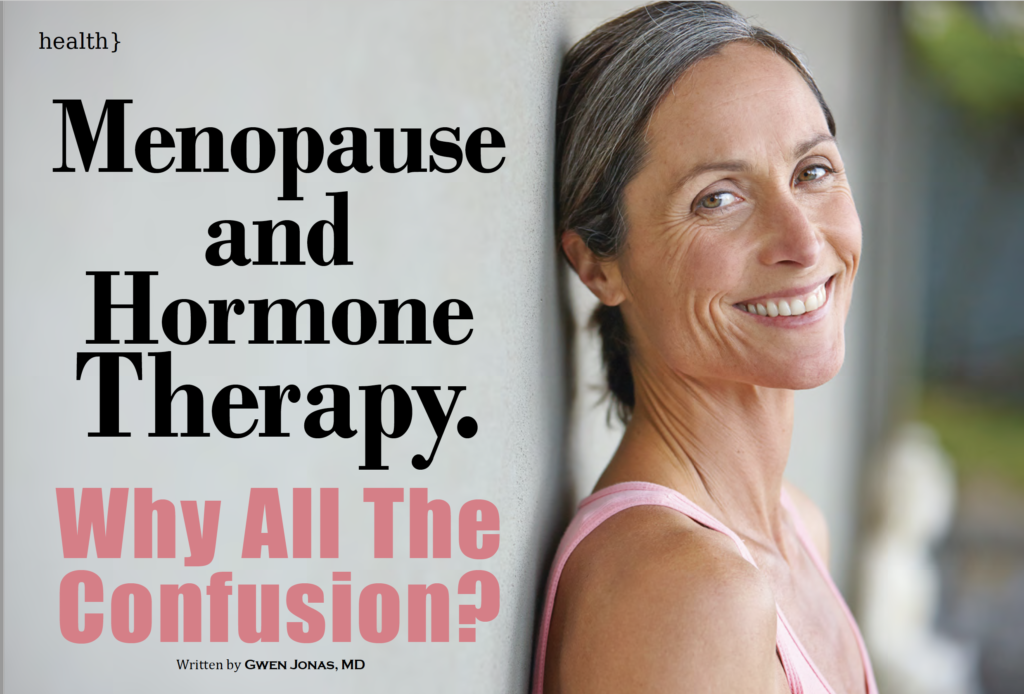Menopause and Hormone Therapy – Why All The Confusion?
Gwen Jonas, MD | Kalispell OB/GYN

Menopause and Perimenopausal Transition
Menopause and the perimenopausal transition are the time leading up to a woman’s last menstrual period. As women, we are considered menopausal when we have not had a period for 12 months (in the absence of other causes). Menopause occurs because of decreased function of our ovaries and, therefore, decreased production of estrogen and other hormones. In the most recent issue of 406 Woman, menopausal changes in vaginal health and how to combat them were explored. Today, we will focus on whole-body symptoms as well as the not-so-obvious effects of menopause and hormonal options for treatment.
Menopausal symptoms are common, with approximately 75% of women experiencing what is called vasomotor symptoms – hot flashes, night sweats (often resulting in difficulty sleeping), heart palpitations, and migraines. Approximately 45% of women will experience symptoms of mood change: depression, anger/irritability, and anxiety. In addition to mood changes, difficulty with memory or concentration and sleep difficulties not related to night sweats may be very disconcerting. As discussed in our previous article on menopause, many women struggle with vaginal dryness, discomfort, and pain with intercourse. All or some of these menopausal symptoms may last 7 to 10 years.
Equally important are the changes that may occur without symptoms – weakening of bones and in-creased risks of heart disease. Weakening of bones begins 1 to 3 years before menopause and lasts for 5-10 years. The average rate of loss of bone is 2% per year with a total of 10-12% loss. This can lead to loss of height, fractures and significant pain, loss of mobility, or even neurologic effects.
The transition through menopause is also associated with increasing risks of coronary heart disease. The loss of estrogen leads to a shift toward worse cholesterol and lipid profiles. In addition, the shift of fat disposition toward the abdomen can lead to greater insulin resistance which increases risks of heart disease.
Hormone Replacement Therapy
Managing symptoms and results of menopause can be done in a myriad of ways, including non-medication interventions, non-hormonal medications, or the replacement of diminishing hormones with hormonal therapy. In this article, we will focus on the latter, as for many women it will be the most effective. Unfortunately, there is a great deal of confusion and confusing information about the safety of hormone replacement therapy. The data from the Women’s Health Initiative in 2001 left many women and providers alike with the impression that hormonal therapy had greater risks than benefits. This, in turn, has resulted in many women going without adequate treatment for significant and life-altering symptoms. But continuing observation of the same women from the 2001 study, as well as other studies in the interim, has revealed that for healthy symptomatic women aged 60 years or within ten years of menopause, the benefits of hormone replacement therapy outweigh the risks. This information has been slow to make its way through the medical community and to the patients who would most benefit from therapy.
Potential benefits of therapy include decreases in hot flashes and night sweats, improved sleep, improvements in memory and the ability to think clearly, decreased vaginal dryness and pain with sex, and decreased bone loss and fracture risks.
The primary goal of hormonal therapy is to raise the blood levels of estrogen back to a level where hot flashes and other symptoms improve or resolve. If you still have a uterus, estrogen will stimulate the uterine lining, and therefore, it is absolutely necessary to take progesterone as well to protect from overstimulation and possible precancerous or cancerous changes of the uterine lining. When considering hormonal therapy, discussing your options with your gynecologic care provider can be helpful in balancing the severity of your symptoms, your personal health history and your own beliefs about hormone therapy. In the last two decades, the predominant discussion about hormones has centered around the risks. Learning the details of benefits and true information about risks will be useful in making decisions about therapy.
Potential benefits of therapy include decreases in hot flashes and night sweats, improved sleep, improvements in memory and the ability to think clearly, decreased vaginal dryness and pain with sex, and decreased bone loss and fracture risks. Women often experience an overall improvement in feelings of well-being. Hormone therapy decreases diagnosis of new-onset type 2 diabetes and may help with blood sugar control in women while it is being used for other symptom management. While the FDA has not approved estrogen therapy to treat depression, research has found that it may be nearly as effective as antidepressant medications in treating depression in perimenopausal (but not postmenopausal) women. In some studies, it appears to prevent depression in peri-menopausal women who do not have depression at the time of initiation. Importantly, for those women initiating therapy within ten years of menopause and at ages less than 60, newer data demonstrates decreased risks of heart disease and death from heart disease. In women initiating hormone therapy beyond the age of 60, cardiac benefit is not seen, and risks likely outweigh benefits.
All medications have some potential risks. As with the risks of heart disease, overall newer information indicates that when hormonal therapy is started in healthy younger women, the benefits generally outweigh the following risks. There is a slightly increased risk of blood clots in the legs or lungs as well as increased risks of stroke with all estrogen-containing preparations except vaginal therapy. If started after the age of 65, estrogen may increase the risk of dementia. If a woman requires both estrogen and progesterone (due to the presence of the uterus), there is a slightly increased risk of breast cancer after 4-5 years of use, but this same degree of risk is not seen with estrogen alone.
Side effects that may be associated with hormone therapy include nausea, breast tenderness or irregular bleeding. Adjustments in dose may help alleviate these effects. Hormonal therapy is not associated with weight gain.
If a woman decides to proceed with hormonal therapy, there are multiple options: pills, gels, patches, sprays, or even a vaginal ring. In general, methods in which the estrogen component is delivered through the skin as opposed to orally are believed to have a lower risk of blood clots and potentially fewer effects on cholesterol. Progesterone is generally given orally and is not associated with blood clots or changes in cholesterol. The lowest dose that relieves symptoms should be used. A women’s healthcare provider can help women work through the options to find the right delivery method and dose.
One area of significant confusion these days results from the term “bioidentical” hormone therapy. Bioidentical refers to hormones that are manufactured to be chemically identical to the hormones women’s bodies make during the reproductive years. There is no scientific data to demonstrate these are safer, but some women and providers may prefer these products.
“Bioidentical” should not be confused with “compounded” hormones. Bioidentical hormones are produced by large pharmaceutical companies as well as small compounding pharmacies. Compounding pharmacies can produce products with varying doses and ratios. It is important to realize that while compounded hormone therapy allows individualized dosing, these doses and formulations may not have been rigorously studied to ensure that the doses have appropriate effects and safety. For instance, the required dose of progesterone to estrogen in a woman with a uterus may or may not be present to ensure the risk of uterine cancer is avoided. Absorption of, and blood levels with, different formulations may not have been well-studied. The North American Menopause Society recommends the use of FDA-approved hormonal therapy for this reason. If a woman feels strongly that she would like to use bioidentical hormones, she should discuss this with her provider and realize there is a long list of bioidentical FDA-approved options. If these do not work for her, compounding may be an appropriate next step.
If a woman is on hormone therapy, deciding when to stop therapy is important. There is no correct time to stop. Newer recommendations from professional organizations state that therapy may be continued beyond 65 years of age. If symptoms persist beyond this time, a woman and her healthcare provider should discuss continuing or discontinuing medications and arrive at this decision together, considering her individual risks and history.
Gwenda C. Jonas, MD, FACOG is a board-certified OB/GYN who has practiced with Kalispell OB/GYN since 2001. This article appears in Jan/Feb 406 Woman Magazine 2024
